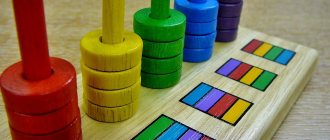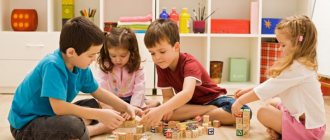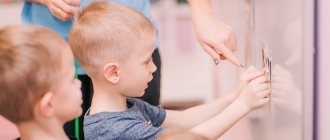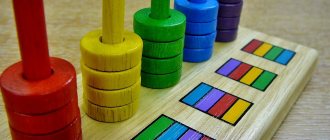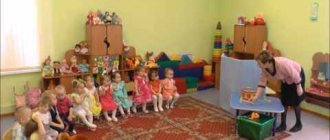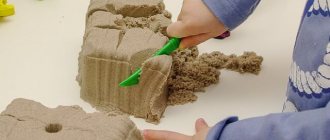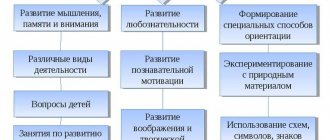Stages of development of thinking in children
Psychologists distinguish three types of thinking characteristic of childhood:
- Visual and effective thinking is characteristic of young children. Children 1.5-2 years old think through actions on objects. They like to throw toys, push things into holes, take things apart, break things, push buttons, and so on. In this way, children accumulate experience and establish the first cause-and-effect relationships (for example, if you throw a ball hard, it will roll far). For the development of this type of thinking, games with sorters, modeling exercises, and games with various materials (sand, water, cereals) are well suited.
One of the main tasks of parents at this stage of mental development is not to interfere with the child’s exploration of the world, creating a safe environment at home for this.
- With the acquisition of speech in early preschool age (3-4 years), visual-figurative thinking . Thanks to the images stored in memory, the child no longer needs to perform real actions with objects. The development of this type of thinking is especially influenced by activities such as drawing and design.
- Verbal and logical thinking begins to form in older preschool age on the basis of figurative thinking. By the age of 5-7 years, children can already reason and operate with some abstract concepts (for example, time, morality, art, etc.). Signs of logical thinking are the ability to establish cause-and-effect relationships, reason, compare and classify.
Human mental activity consists of mental operations. The ability to use them is to show the development of a preschooler’s thinking.
| Mental operation | Essence | Example |
| Comparison | The ability to find commonality in different things and different things in similar things. | What do cranberries and lemons have in common? - They are sour. What is the difference between a tangerine and an orange? - Size. |
| Generalization | Combining a number of items according to common essential characteristics. | What is a cup, plate, frying pan, pan? - These are dishes. |
| Analysis | Identification of properties or parts of objects and phenomena. | What parts does a plant consist of? – Roots, stem, leaves, flower. |
| Synthesis | Combining parts or properties of an object into one whole. | What do you get if you combine the letters “k”, “o”, “w”, “k” and “a”? - The word "cat". |
If a child develops harmoniously both figurative and logical types of thinking, it is easier for him to solve various problems.
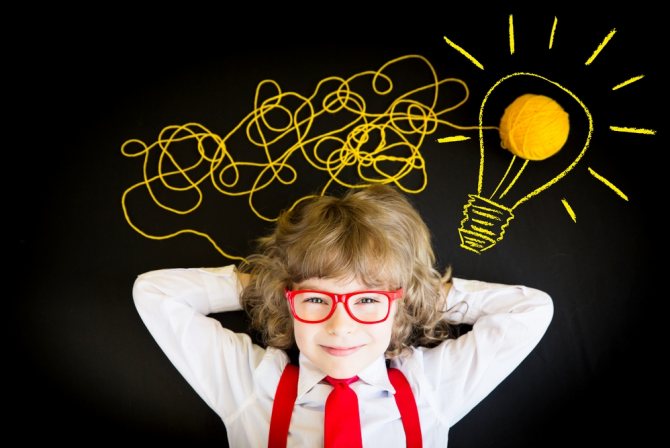
Mastering mental operations in preschool age
Generalization goes through a fairly significant development path during the preschool period. As an example, S. L. Rubinstein compares the answers that Natasha Sh. gave to her mother to the same question at the 3rd, 4th, 5th and 6th years of life.
“Natasha is 2 years 4 months old, she is a healthy, rosy-cheeked girl, she speaks a lot, although she speaks incorrectly. Today I asked Natasha: “What is a mother?” She looked at me, burst into laughter and, pointing her finger at me, repeated: “Here’s mom, here’s mom.” Then I said: “But a strange girl who doesn’t have a mother will come to us, and she will ask you what a mother is, how will you explain to her?” Natasha looks in bewilderment, it’s hard for her to imagine that a girl might not have a mother, and says: “Mom, here’s mom,” pointing at me.
I asked Natasha a question about how to explain what a mother is when she was 3 years 5 months old. Without hesitation, she said: “Mom, it’s you, Anna Petrovna, she has a girl - it’s me.”
At 4 years 4 months old, when asked how to explain what a mother is, Natasha answered: “Mom never erases, she writes everything.”
At 5 years 6 months, I again asked Natasha what a mother was. "Mother? - she asked again and answered: “A mother is a woman who gives birth to children.” Then I asked: “Does she have children or give birth?” “No,” she answered confidently, “she’s giving birth, but she doesn’t have it.” You can have other people's children. Emma has me, but she is not a mother. Mother is who gives birth to children” (2).
The difficulties of forming general concepts in children are described in detail in the work of L. S. Vygotsky “Thinking and Speech.” The author talks about experimental learning for a child. This child without much difficulty learns a number of words: “table”, “chair”, “cabinet”, “sofa”, “shelf”. He could increase such a series of words as much as he wanted. But he is unable to assimilate the word “furniture” as the sixth word, since this word denotes a more general concept in relation to the previous words. Learning the word “furniture” is not at all the same as adding a sixth word to the existing five. Here it is necessary to master the relation of generality, to acquire a higher concept, which includes the entire series of more particular concepts subordinate to it. The same child easily learns a series of words: “shirt”, “hat”, “fur coat”, “pants” - and can easily continue this series, but cannot learn the word “clothes”. Analyzing these facts, L. S. Vygotsky comes to the conclusion that at a certain stage of development, such relations of generality between concepts are generally inaccessible to the child. “The appearance of the first higher concept, standing above a number of previously formed concepts, the appearance of the first word like “furniture” or “clothing” is no less important a symptom of progress in the development of the semantic side of children’s speech than the appearance of the first meaningful word” (3).
However, the nature of generalizations changes with age in a preschooler. Children gradually move from operating with external signs to revealing signs that are objectively more significant for the subject. A higher level of generalization allows the child to master the classification operation, which involves assigning an object to a group based on species-generic characteristics. The development of the ability to classify objects is associated with the development of generalizing words, the expansion of ideas and knowledge about the environment and the ability to identify significant features in an object. Moreover, the closer the objects are to the personal experience of the preschooler, the more accurate the generalization he makes. The child first of all identifies groups of objects with which he actively interacts: toys, furniture, dishes, clothes. With age, differentiation of related classification groups occurs: wild and domestic animals, tea and tableware, wintering and migratory birds.
Junior and middle preschoolers often motivate the identification of classification groups by the coincidence of external signs (“The sofa and the chair are together because they are in the room”) or based on the use of the purpose of objects (“they eat them,” “they put them on themselves”). Older preschoolers not only know generalizing words, but also, based on them, correctly motivate the identification of classification groups. Let's give an example.
Natasha M. (7 years old) picks up the pictures and looks at them for 5 seconds. Starts to unfold. Combines skirt, coat, dress, trousers: This is because the clothes. Further.
He takes the cards and lays them out: Cow, dog, cat, horse - these are our pets. Now wild.
Lays out: wolf, bear, fox, hare. Then he lays out: potatoes, carrots, tomatoes, cabbage, cucumber: These are vegetables. What else is there?
Lays out: bus, trolleybus, car, boat: This is transport. More furniture.
Lays out: wardrobe, table, bed, sofa, chair: Now toys.
Lays out: bear, matryoshka, pyramid. He picks up a picture of an airplane, puts it next to it, looks at the adult: Is this transport?
Adult: Yes.
Natasha puts the picture in the transport pile.
In the process of abstraction in preschoolers, the difficulty of identifying the main, essential is clearly manifested in the retelling of the text. Psychologist A.I. Lipkina noticed that a short retelling is much more difficult for children than a detailed one. To tell briefly means highlighting the main thing, separating it from the details, and this is precisely what children do not know how to do. If you ask children to tell a short story, to tell only the main thing, they often miss significant semantic points, and the meaning of their retelling suffers greatly from this. To shorten a story and highlight only the main thing in it is not one task for a student, but two, and he often cannot master them at the same time. After all, identifying the main thing is a choice from the total number of connections of a few, and for the child they are still all the main ones (4).
Inability to distinguish between the general and the particular, the main and the secondary, i.e. inability to perform logical analysis often leads to erroneous conclusions due to the fact that children judge objects on the basis of secondary, insignificant features.
The inability to identify the general and the most important leads to significant difficulties in mastering the concept of invariance. As studies by the outstanding Swiss psychologist J. Piaget have shown, young children do not understand that the same amount of water will actually be the same in a narrow glass, where the water level rises high, and in a wide glass, where this level is low. They do not understand this even when water is poured in their presence and they see that its quantity neither decreases nor increases (5).
Thus, the examples given show that the child’s thinking is concrete, and the process of abstraction presents significant difficulty for him. However, different types of abstraction are difficult to different degrees.
With age, the preschooler compares objects based on more numerous characteristics. He notices even slight similarities between the external signs of objects and expresses the differences in words.
Isolating the essential is one side of the abstraction process (positive). Distraction from the unimportant is its other side (negative). Numerous observations and studies show that in both children and adults, the negative side of the abstraction process is more difficult than the positive one: abstracting from the unimportant occurs with greater difficulty than isolating the essential. The ability to cope with the negative side of the abstraction process is a very subtle indicator of the formed ability to hold a task and subordinate one’s mental activity to a given task. Therefore, a preschool teacher needs to persistently teach children not only to highlight the main thing, but also to abandon the unnecessary or unimportant.
In addition, special training is needed, aimed at consciously highlighting the main thing and discarding the secondary. For example, highlight those parts of the story that are most significant for revealing its content. Or, when presenting the text, omit minor points that are not essential for its understanding. Or compare any phenomena that are similar in the main and differ from each other in particular, secondary manifestations, and at the same time clearly explain what is essential here and what is not.
“Abstractions purify and simplify the material and thus significantly facilitate actions, but if you start with such simplified material, then the difficulty arises of combining theoretical knowledge with practical actions,” warns P. Ya. Galperin (6).
Preschool children often find it difficult to give examples to illustrate their answer. Therefore, the teacher should not be content with the fact that children correctly reproduce general provisions, but should strive to make these provisions more specific: giving an example, an illustration, a specific particular case. When the teacher himself gives an example, he reveals and shows how in this particular case a general thing is revealed, which is illustrated by the example. Only under this condition does the particular provide significant assistance to the understanding of the general.
Thus, the formation of a qualitatively new way of thinking in a preschool child is associated with the development of mental operations. In preschool age, they develop intensively and begin to act as methods of mental activity.
See other articles on the development of children's thinking here.
1. Uruntaeva G. A., Afonkina Yu. A. Workshop on preschool psychology. - M.: Publishing House, 1998. P. 185.
2. RubinsteinS. L. Fundamentals of general psychology. —SPb.: Peter, 2005. P. 353.
3. Vygotsky L. S. Thinking and speech // Collection. cit.: In 6 vols. T. 1. – M.: Pedagogy, 1982. P. 273.
4. Rotenberg V. S., Bondarenko S. M. Difficulties of children's thinking // Age and educational psychology: Reader / Comp. I. V. Dubrovina, A. M. Prikhozhan, V. V. Zatsepin. - M.: Academy, 2003. - P. 158–159.
5. Rotenberg V. S., Bondarenko S. M. Difficulties of children's thinking // Age and educational psychology: Reader / Comp. I. V. Dubrovina and others - M.: Academy, 2003. P. 158.
6. Study of thinking in Soviet psychology / Ed. E. V. Shorokhova. – M., 1969. P. 262.
Games and exercises for the development of imaginative and logical thinking
- “What does it look like?” Show your child a picture of a fancy blot. Let the child come up with as many original associations for it as possible.
- "The fourth is odd." Invite your child to look at 4 pictures, three of which can be combined according to some characteristic. The child must understand which picture is “extra” and explain why he thinks so.
- “Call it in one word.” This game consists of an adult offering the child a set of words or images that can be combined into a concept. The child’s task is to name objects in one word (for example, tit, nightingale, woodpecker, crow, hawk - birds; raspberries, gooseberries, strawberries, watermelons - berries).
- “Put it into groups.” An adult places pre-prepared objects or their images on the table and mixes them. The preschooler must sort them into groups according to some characteristic.
- “Fold the picture.” This didactic game is an analogy to puzzles. The child’s task is to put together a whole picture from several parts.
- "Sudoku". This puzzle, popular all over the world, in its simplified version (2x2, 3x3 or 4x4), is also suitable for preschoolers.
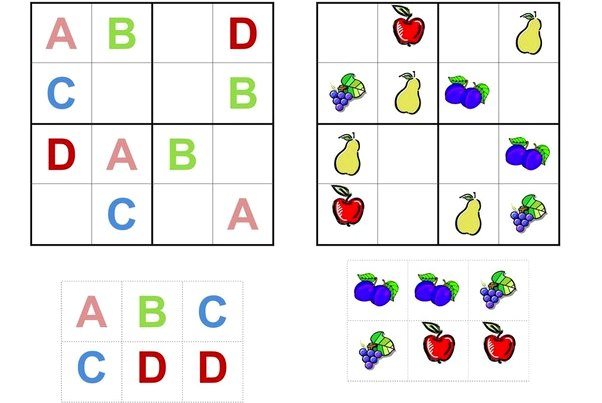
- “Who eats what?” Select pictures depicting animals and their favorite delicacies, mix them, and then ask the child to make pairs (feed the animals). By analogy, you can play games such as “Moms and Their Babies”, “Who Lives Where?”, “Signs of the Seasons” and so on.
- “Continue the row.” Draw long beads and start a sequence of bead colors (for example, red, yellow, blue, red again). The child must color the rest of the beads, following the pattern.
To make it interesting and fun for your baby, try to introduce your child to new games and exercises every time.
- "Opposites". In this game, the child needs to come up with a word with the opposite meaning. For example, you say the word “big”, and the child says “small” (“cheerful” - “sad”, “loud” - “quiet”, “fast” - “slow”, and so on).
- "Guess what it's about." This game will help develop not only thinking, but also attentiveness. Describe one of the objects in the room, and the child must guess what it is about. For example, a fragile, glass, beautiful vase.
For other useful games and exercises, watch the video:
Board games (checkers, chess, strategy games), mazes and puzzles are also suitable for developing the thinking of preschoolers. Such games allow kids to learn how to make decisions, think through moves, and assess possible risks. Role-playing games, communicating with peers, reading and discussing books are also great for developing creative thinking.
Questions as a stimulus for thought
The questions that require children to think can be different, but they should all be aimed at activating their existing knowledge.
For example, what does a plant grow from?
- What kind of transport is called water transport?
- Which one is ground-based?
- Which one is airborne?
- Why doesn't a ball sink in water, but a round stone does?
- Will a snow woman become warm if she is dressed in a fur coat?
- What do birds that fly to warmer regions for the winter eat?
- Why is the balloon big but light?
- Why do puddles quickly disappear after rain in summer?
- Why does snow begin to melt in spring?
- Do trees grow in winter?
- Why, when a bouquet is placed in a vase, is water poured into it?
- Why does a duck have webbing between its toes, but a chicken does not?
conclusions
Preschool childhood is a period in a person’s life during which he acquires basic knowledge, skills and abilities, and his personality and intellect are formed. Among the most important mental new formations is thinking. It is with its help that the child gets to know himself and the world around him. Children of early age are characterized by a visual-effective type of thinking; in early preschool age, a visual-figurative type is formed, and in older preschool age, a verbal-logical type of thinking is revealed to the child (although figurative thinking remains the leading one). The development of a child’s thinking depends on experience, so it is very important to provide the child with the opportunity to see the world as widely as possible, as well as to train his thinking abilities. Thinking development activities can be interesting and exciting if done in a playful way. Choose exercises that you also like, because when both an adult and a child enjoy the process, the result will be much better.

1.2. Physiological basis of thinking
Like all mental processes, thinking is an activity of the brain.
The physiological basis of thinking is temporary nerve connections (conditioned reflexes), which are formed in the cerebral cortex. These conditioned reflexes arise under the influence of second signals (words, thoughts), reflecting reality, but they necessarily arise on the basis of the first signal system (sensations, perceptions, ideas).
I.P. Pavlov wrote that “kinesthetic stimuli coming to the cortex from the speech organs are second signals, signals of signals. They represent an abstraction from reality and allow for generalization, which constitutes our superfluous, specifically human, higher thinking...”
That is, the physiological basis of thinking is brain processes at a higher level than those that serve as the basis for more elementary mental processes, such as sensation. However, at present there is no consensus on the significance and order of interaction of all physiological structures that support the thinking process. It is undeniable that the frontal lobes of the brain play a significant role in mental activity as one of the options for purposeful activity. In addition, there is no doubt about the importance of those areas of the cerebral cortex that provide gnostic (cognitive) functions of thinking. There is no doubt that the speech centers of the cerebral cortex are also involved in ensuring the thought process.
Unlike sensations, perceptions and memory, second-signal connections are more complex systems that reflect various relationships between objects and phenomena.
In thinking processes, both signaling systems are closely related to each other. The second signaling system allows for unlimited orientation in the surrounding world; through it, “the highest human adaptation - science” is created.
But the second signaling system relies on the first. If words are deprived of a certain real meaning for a person, if a person cannot correlate them with some specific objects and phenomena, then such words cease to be signals of reality. Thinking proceeds normally only with the participation of both signaling systems, but the leading role remains with the second signaling system, since the word is a signal richer in content and is associated with the processes of abstraction and generalization.
The complexity of studying the physiological foundations of thinking is explained by the fact that in practice thinking as a separate mental process does not exist. Thinking is present in all other cognitive mental processes, including perception, attention, imagination, memory, and speech. All higher forms of these processes, to a certain extent, depending on the level of their development, are associated with thinking.
Thus, thinking is a complex analytical and synthetic activity carried out by the joint work of both signaling systems. Moreover, since thinking is a reflection of reality generalized using a word, the second signaling system plays a leading role in this activity. Constant and close interaction with the first signaling system determines the inextricable connection of the generalized reflection of reality, which is thinking, with sensory knowledge of the objective world through sensations, perceptions, ideas.
